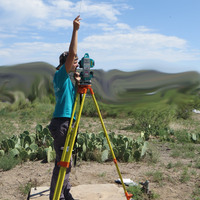Erin Christine Rodriguez
University of California, Berkeley, Anthropology, Graduate Student
- University of Pittsburgh, Anthropology, Undergraduateadd
- Archaeological Soil Micromorphology, Gender Archaeology, Household Archaeology, Archaeology, Public Archaeology, Geoarchaeology, and 18 moreLandscape Archaeology, Anthropology, Environmental Archaeology, Archaeological Science, Historical Archaeology, Archaeological Method & Theory, Experimental Archaeology, Archaeological Theory, Archaeological Fieldwork, Prehistory, Gender Studies, Gender, History of Archaeology, Queer Theory, Soil Chemistry, Queer Pedagogy, Theory and practice in Archaeology, and Queer Archaeologyedit
A queer theory inspired perspective is valuable not only for broadening the scope of archaeological interpretation and our understanding of past lived experiences, but also for informing an archaeological pedagogy which expands the... more
A queer theory inspired perspective is valuable not only for broadening the scope of archaeological interpretation and our understanding of past lived experiences, but also for informing an archaeological pedagogy which expands the diversity of authoritative viewpoints in the discipline. Field schools, as one of the most central aspects of archaeological training, have the potential to either reaffirm heteronormative structures which obscure non-conforming persons and viewpoints or to promote inclusive practices that can benefit the field by expanding the range of experiences, perspectives, and voices in the archaeological discussion. This paper will discuss specific ways in which an explicitly queer-informed field school acts to create a safe space where inclusion is based on analytic archaeological potential rather than correct conformation to perceived social norms.
Research Interests:
Microscale geoarchaeology, specifically soil micromorphology, has incredible potential for enriching archaeological understandings of the materiality of past experience through detailed information on the events, actions, and processes... more
Microscale geoarchaeology, specifically soil micromorphology, has incredible potential for enriching archaeological understandings of the materiality of past experience through detailed information on the events, actions, and processes which create archaeological sites. Soil micromorphological analysis can parallel the strict time scales available through historic documentation with material evidence of specific human, non-human, and natural events. This paper shows how micromorphological approaches can be integrated into a historical archaeology project through examples from the Fort Davis Archaeological Project in Fort Davis, Texas. Micromorphological sampling during field season 2014 was crucial in understanding the development of archaeological sites excavated by the project, particularly in terms of deposition and the effects of water action on archaeological features. Furthermore, micromorphological analysis was incorporated into the analysis of living spaces and depositional practices at several sites analyzed by the project. Using these examples this paper shows how integrating microscale geoarchaeology within a historical archaeological framework provides a material and temporal correlate to historical and artifactual modes of analysis which are standard practice within historical archaeology.
